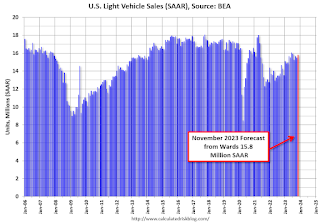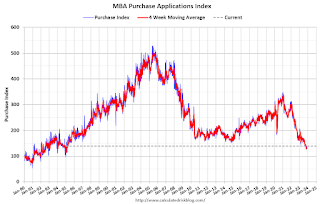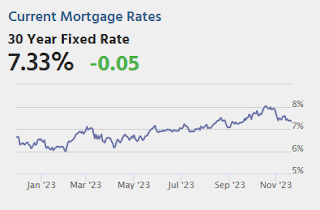by Calculated Risk on 11/24/2023 03:25:00 PM
Friday, November 24, 2023
Hotels: Occupancy Rate Decreased 0.6% Year-over-year
U.S. hotel performance showed mixed year-over-year comparisons, according to CoStar’s latest data through 18 November. ...The following graph shows the seasonal pattern for the hotel occupancy rate using the four-week average.
12-18 November 2023 (percentage change from comparable week in 2022):
• Occupancy: 62.4% (-0.6%)
• Average daily rate (ADR): US$156.47 (+7.0%)
• Revenue per available room (RevPAR): US$97.61 (+6.3%)
emphasis added
 Click on graph for larger image.
Click on graph for larger image.The red line is for 2023, black is 2020, blue is the median, and dashed light blue is for 2022. Dashed purple is for 2018, the record year for hotel occupancy.
Realtor.com Reports Active Inventory UP 1.5% YoY; New Listings up 5.0% YoY
by Calculated Risk on 11/24/2023 12:31:00 PM
Realtor.com has monthly and weekly data on the existing home market. Here is their weekly report: Weekly Housing Trends View — Data Week Ending Nov 18, 2023
• Active inventory increased slightly, with for-sale homes 1.5% above year ago levels. Active listings exceeded last year’s levels again this week, falling in line with last week’s trend.
• New listings–a measure of sellers putting homes up for sale–were up this week, by 5.0% from one year ago. New listings registered lower than prior year levels from mid-2022 through roughly 4 weeks ago, as the mortgage rate lock-in effect freezes homeowners with low-rate existing mortgages in place. Over the last three weeks, however, the trend has reversed and new listings during this week outpaced the same week in the previous year by 5.0%.
 Here is a graph of the year-over-year change in inventory according to realtor.com.
Here is a graph of the year-over-year change in inventory according to realtor.com. Inventory was up year-over-year for the 2nd consecutive week following 20 consecutive weeks with a YoY decrease in inventory.
Q4 GDP Tracking: Around 2%
by Calculated Risk on 11/24/2023 10:40:00 AM
From BofA:
Overall, this reduced our 4Q US GDP tracking estimate down a tenth to 1.4% q/q saar from our official forecast of 1.5% q/q saar. Also, 3Q GDP remains unchanged from our last weekly publication at 5.2% q/q saar. [Nov 22nd estimate]From Goldman:
emphasis added
The inventory details of the durable goods report were firmer than our previous assumptions, and we boosted our Q4 GDP tracking estimate by one tenth to +2.0% (qoq ar). Our Q4 domestic final sales estimate also stands at +2.0%. [Nov 22nd estimate]And from the Altanta Fed: GDPNow
The GDPNow model estimate for real GDP growth (seasonally adjusted annual rate) in the fourth quarter of 2023 is 2.1 percent on November 22, up from 2.0 percent on November 17. After recent releases from the US Census Bureau and the National Association of Realtors, the nowcast of fourth-quarter real gross private domestic investment growth increased from -1.8 percent to -1.1 percent. [Nov 22nd estimate]
Thursday, November 23, 2023
Five Economic Reasons to be Thankful
by Calculated Risk on 11/23/2023 08:47:00 AM
Here are five economic reasons to be thankful this Thanksgiving. (Hat Tip to Neil Irwin who started doing this years ago)
1) The Unemployment Rate is Below 4%

The unemployment rate is up from 3.7% a year ago (October 2022).
2) Low unemployment claims.
 This graph shows the 4-week moving average of weekly claims since 1971.
This graph shows the 4-week moving average of weekly claims since 1971.The dashed line on the graph is the current 4-week average.
3) Inflation is Decreasing
 This graph shows the year-over-year change in three measures of inflation since 1970: CPI, Core CPI, and Core CPI ex-shelter.
This graph shows the year-over-year change in three measures of inflation since 1970: CPI, Core CPI, and Core CPI ex-shelter. Overall inflation is moving back to the Fed's 2% target.
4) Mortgage Delinquency Rate Near the Lowest Level since at least 1979

The percent of loans in the foreclosure process decreased year-over-year in Q3 even with the end of the foreclosure moratoriums and are historically low.
5) Household Debt burdens at Low Levels
 This graph, based on data from the Federal Reserve, shows the Total Debt Service Ratio (DSR), and the DSR for mortgages (blue) and consumer debt (yellow).
This graph, based on data from the Federal Reserve, shows the Total Debt Service Ratio (DSR), and the DSR for mortgages (blue) and consumer debt (yellow).This data suggests aggregate household cash flow is in a solid position.
Wednesday, November 22, 2023
Black Knight: Mortgage Delinquency Rate Decreased in October
by Calculated Risk on 11/22/2023 02:35:00 PM
From ICE / Black Knight: ICE First Look at Mortgage Performance: Foreclosure starts rose in October, despite serious delinquencies returning to 17-year lows
• The national delinquency rate fell 3 basis points (bps) to 3.26% in October, marking a 9 bps (-2.8%) improvement from the same time last year
• Serious delinquencies (90+ days past due) fell to 447K, once again hitting their lowest levels since 2006
• Loans 30-days late also declined, marking the first such improvement in five months
• Despite the improvement in delinquencies, foreclosure starts rose to 33K in October, hitting their highest levels in 18 months – while the number of foreclosure sales (completions) remained relatively flat
• Active foreclosure inventory inched up 3K to 217K, but remains more than 25% below prepandemic levels
• While foreclosure starts rose in October, near term risk remains muted, with serious delinquencies historically low and more than 70% of such loans protected from foreclosure by loss mitigation efforts
• Prepay activity (measured as single-month mortality) dwindled to just 0.43% under continued seasonal pressure, despite interest rates easing somewhat from the prior month
| Black Knight: Percent Loans Delinquent and in Foreclosure Process | ||||
|---|---|---|---|---|
| October 2023 | September 2023 | |||
| Delinquent | 3.26% | 3.29% | ||
| In Foreclosure | 0.41% | 0.40% | ||
| Number of properties: | ||||
| Number of properties that are delinquent, but not in foreclosure: | 1,734,000 | 1,749,000 | ||
| Number of properties in foreclosure pre-sale inventory: | 217,000 | 214,000 | ||
| Total Properties | 1,951,000 | 1,963,000 | ||
November Vehicle Sales Forecast: 15.8 million SAAR, Up 11% YoY
by Calculated Risk on 11/22/2023 01:30:00 PM
From WardsAuto: November U.S. Light-Vehicle Sales to Improve on Past Three Months (pay content). Brief excerpt:
The recent falloff in the SAAR from summer highs could mean more consumers are reaching price fatigue. It also could be that some of the stronger selling segments – especially fullsize trucks – of the past two-plus years are closer than other segments to meeting the pent-up demand built up since the inventory drain caused by the semiconductor shortage began in early 2021. Of course, there also has been a rise in distractions over that period, locally and internationally.
emphasis added
 Click on graph for larger image.
Click on graph for larger image.This graph shows actual sales from the BEA (Blue), and Wards forecast for November (Red).
On a seasonally adjusted annual rate basis, the Wards forecast of 15.8 million SAAR, would be up 2% from last month, and up 11% from a year ago.
Lawler on Existing Home Sales, Population Projections and Household Slowdown
by Calculated Risk on 11/22/2023 09:34:00 AM
Today, in the CalculatedRisk Real Estate Newsletter: Lawler on Existing Home Sales, Population Projections and Household Slowdown
Excerpt:
Census’ new long-term US population projections released last Friday were massively lower than the previous long-term projection released in 2017. In a report earlier this week I highlighted the how the projected components of population change (births, deaths, and net international migration) differed in the two forecasts. Today I’m going to highlight a few “issues” with the latest projections over the next few years.There is much more in the article. You can subscribe at https://calculatedrisk.substack.com/ Please subscribe!
First, the “projected” components of change from July 1, 2022, to June 30, 2023, differ significantly from likely components of change based on existing information.
For deaths, the latest projection shows deaths from July 1, 2022, to June 30, 2023, of 2,861,510, a whopping 298,232 lower than CDC provisional data for that period show (this latter number will be revised upward slightly). In looking at deaths by age, mortality rates are “too low” in the latest long-term projection for almost all age groups, but especially for young to middle-aged adults.
For net international migration (NIM), the latest projection shows NIM from July 1, 2022, to June 30, 2023, of 853,220, or a sizeable 157,703 below the estimated NIM from July 1, 2021, to June 30, 2022, in the Vintage 2022 population estimates. Yet the admittedly limited data available on immigration trends suggest the NIM INCREASED from 2022 to 2023, and my best estimate in that NIM from July 1, 2022, to June 30, 2022, was about 1,200,000 – 346,780 higher than the assumption in the latest long-term population projection.
Finally, births in the latest long-term population projection from July 1, 2022, to June 30, 2023, are 18,788 below provisional CDC data for this period.
Weekly Initial Unemployment Claims Decrease to 209,000
by Calculated Risk on 11/22/2023 08:30:00 AM
The DOL reported:
In the week ending November 18, the advance figure for seasonally adjusted initial claims was 209,000, a decrease of 24,000 from the previous week's revised level. The previous week's level was revised up by 2,000 from 231,000 to 233,000. The 4-week moving average was 220,000, a decrease of 750 from the previous week's revised average. The previous week's average was revised up by 500 from 220,250 to 220,750.The following graph shows the 4-week moving average of weekly claims since 1971.
emphasis added
 Click on graph for larger image.
Click on graph for larger image.The dashed line on the graph is the current 4-week average. The four-week average of weekly unemployment claims decreased to 220,000.
The previous week was revised up.
Weekly claims were much lower than the consensus forecast.
MBA: Mortgage Applications Increased in Weekly Survey
by Calculated Risk on 11/22/2023 07:00:00 AM
From the MBA: Mortgage Applications Increase in Latest MBA Weekly Survey
Mortgage applications increased 3.0 percent from one week earlier, according to data from the Mortgage Bankers Association’s (MBA) Weekly Mortgage Applications Survey for the week ending November 17, 2023.
The Market Composite Index, a measure of mortgage loan application volume, increased 3.0 percent on a seasonally adjusted basis from one week earlier. On an unadjusted basis, the Index decreased 0.1 percent compared with the previous week. The Refinance Index increased 2 percent from the previous week and was 4 percent lower than the same week one year ago. The seasonally adjusted Purchase Index increased 4 percent from one week earlier. The unadjusted Purchase Index decreased 1 percent compared with the previous week and was 20 percent lower than the same week one year ago.
“U.S. bond yields continued to move lower as incoming data signaled a softer economy and more signs of cooling inflation. Most mortgage rates in our survey decreased, with the 30-year fixed mortgage rate decreasing to 7.41 percent, the lowest rate in two months,” said Joel Kan, MBA’s Vice President and Deputy Chief Economist. “Mortgage applications increased to their highest level in six weeks, but remain at very low levels. Purchase applications were up almost four percent over the week, on a seasonally adjusted basis, as both conventional and government purchase loans saw increases. The average loan size on a purchase application was $403,600, the lowest since January 2023. This is consistent with other sources of home sales data showing a gradually increasing first-time homebuyer share.”
Added Kan, “Refinance applications increased 1.6 percent last week, but the level of refinances continues to be well below historical averages, given that most borrowers already have a rate well below current market rates.”
...
The average contract interest rate for 30-year fixed-rate mortgages with conforming loan balances ($726,200 or less) decreased to 7.41 percent from 7.61 percent, with points decreasing to 0.62 from 0.67 (including the origination fee) for 80 percent loan-to-value ratio (LTV) loans.
emphasis added
 Click on graph for larger image.
Click on graph for larger image.The first graph shows the MBA mortgage purchase index.
According to the MBA, purchase activity is down 20% year-over-year unadjusted.

Tuesday, November 21, 2023
Wednesday: Unemployment Claims, Durable Goods
by Calculated Risk on 11/21/2023 08:38:00 PM

Wednesday:
• At 7:00 AM ET, The Mortgage Bankers Association (MBA) will release the results for the mortgage purchase applications index.
• At 8:30 AM, The initial weekly unemployment claims report will be released. The consensus is for 229 thousand initial claims, down from 231 thousand last week.
• Also at 8:30 AM, Durable Goods Orders for October from the Census Bureau. The consensus is for a 3.0% decrease in durable goods orders.
• At 10:00 AM, University of Michigan's Consumer sentiment index (Final for November).


